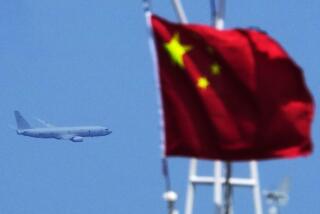No ordinary day at Tiananmen Square
- Share via
BEIJING — 4:45 a.m. The sky is still murky with night when the hard-core convene at Tiananmen Square. Only the most patriotic Chinese and the most dedicated tourists have yanked themselves out of bed to watch the Chinese flag rising over Beijing at sunrise.
As the sun peeks out over the high-rises of the nearby financial district, the guards in military regalia goose-step to the flagpole for the daily ritual in front of the iconic portrait of Mao Tse-tung. The billowing red flag climbs slowly to an accompaniment of the national anthem pumped out of loudspeakers around the square.
Just like every other day, people snap pictures of themselves in front of the “Gate of Heavenly Peace” (Tiananmen, in Mandarin), where Mao proclaimed the founding of the nation in 1949. Just like every other day, they line up at the mausoleum where his body lies preserved under glass and pose next to the 10-story obelisk Monument to the People’s Heroes.
But this day is not like every other day. It is June 4, the 20th anniversary of the brutal crackdown by the army that left hundreds, perhaps thousands, of pro-democracy demonstrators dead.
On this day, there are commemorative ceremonies all around the world -- in Washington, London, Hong Kong, Los Angeles. Almost everywhere, it would seem, but here, where it happened.
Dissidents around China have been put under house arrest to prevent any attempt to enter the square. Foreign news media have been barred for the day. The entire 100 acres are fenced off with police barricades. White tents like the ones used for the happier occasion of last summer’s Olympic Games are outfitted with metal detectors. The authorities look not just for weapons, but also papers and scarves that might be unfurled into a banner.
Some visitors are asked to show their passports; those who have Chinese “J” visas (the letter indicating the holder is a journalist) are turned away.
5:20 a.m. The crowd thins out after the flag-raising. About 200 are left, mostly people from Chinese tour groups, wearing matching hats. A few old men are flying kites.
It is becoming increasingly apparent that there will be more security than visitors at Tiananmen Square today.
10:30. a.m. Buses are lined up in neat rows at the south end of the square. They look like ordinary tour buses, but the people piling out are clearly not ordinary tourists. They’re all male. They carry umbrellas to shield themselves from the sun -- a habit common for Chinese women, unusual for men. Many wear matching outfits and carry matching umbrellas. About a dozen paunchy middle-aged men wear red polo shirts and have little black wires dangling from their ears. A group of younger men wears pink T-shirts. Another group wears purple.
Hardly anybody wears white. In the last few days, before the government blocked Twitter, Hotmail and a dozen other websites, the word was spreading that people should come to the square in white, the traditional Chinese color of mourning. But nobody has dared.
2 p.m. As the temperature rises, so do the umbrellas. Tiananmen Square looks like an ocean of umbrellas, bobbing around like little boats on the waves. The plainclothes policemen wield their matching umbrellas like shields. They not only want to block the sun; they also hide coyly behind their umbrellas to prevent people from taking their photographs.
There must be seven or eight security personnel for every visitor at the square. A construction supervisor says he was told by the police that 200,000 would be deployed for the day around Tiananmen.
“They’re really afraid that the students might do something again,” says the man, who of course does not give his name.
In fact, he is chattier about the unspeakable than most people at Tiananmen Square. A middle-aged woman selling umbrellas lowers her voice to a whisper when asked about the large number of police.
“Don’t you know? It’s 6-4,” she says, using the shorthand, like 9/11, to refer to a tragedy too enormous to name. “But better not to talk about that.”
Even the real tourists are on edge. A Chinese guide speaking in English to a group of mostly South Korean tourists lowers his voice as well to advise his wards to behave themselves.
“We’re where we are, so no shouting, no running, no fooling around. Don’t act stupid.”
7:15 p.m. An afternoon shower has washed away the heat. A large crowd has gathered to watch the flag-lowering ceremony at sunset. The mood is almost festive. A man has made a picnic blanket for himself with a map of Beijing. He sits and takes off his loafers. A Western tourist sits on the ground and enjoys a large green bottle of local beer.
7:35 p.m. The sun is ducking behind a line of trees northwest of the square. The guards begin to lower the flag. The crowd hushes and presses forward toward the barriers. Children are lifted onto parents’ shoulders. A young hipster lightheartedly sings the opening lines of “The Internationale,” the communist anthem.
7:45 p.m. A voice on the public address system asks people to leave the square in an orderly fashion. One plainclothes policeman says to another, “Goodbye, I’m taking a car home.”
The square is closed off. The anniversary has come and gone for Tiananmen.
--
This article was reported by Times staff writers Demick and Pierson and other members of The Times’ Beijing Bureau.
More to Read
Sign up for The Wild
We’ll help you find the best places to hike, bike and run, as well as the perfect silent spots for meditation and yoga.
You may occasionally receive promotional content from the Los Angeles Times.







